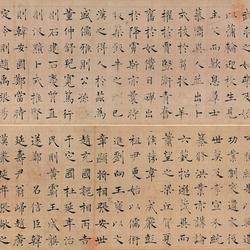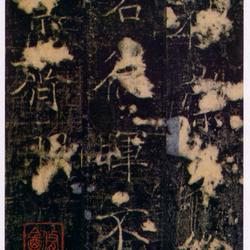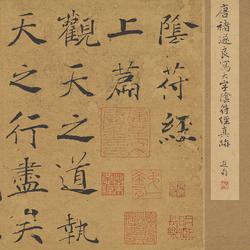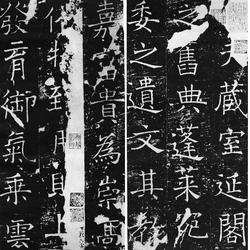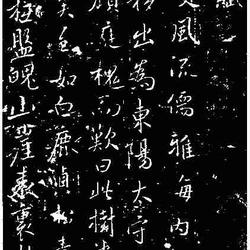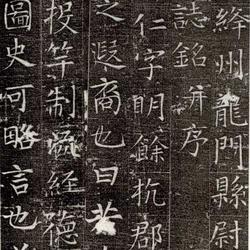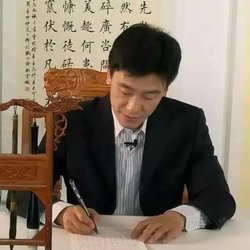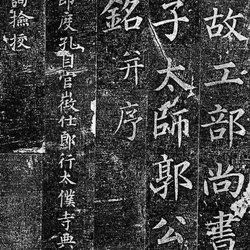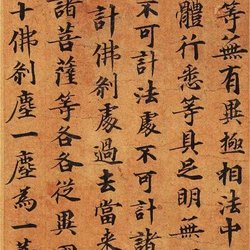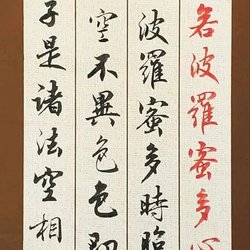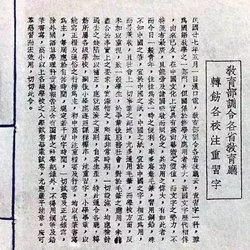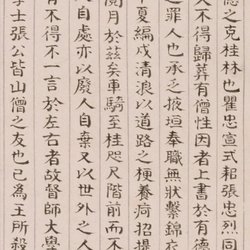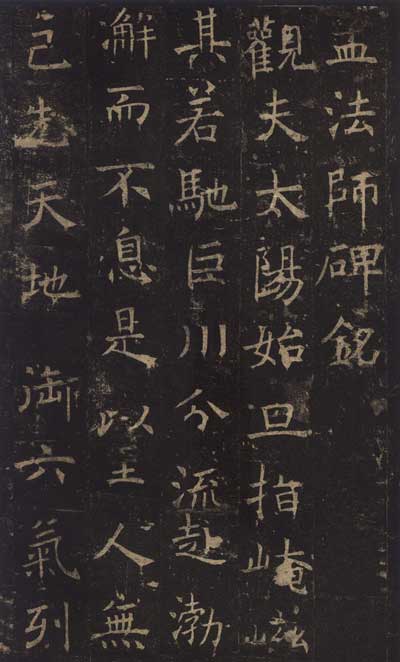
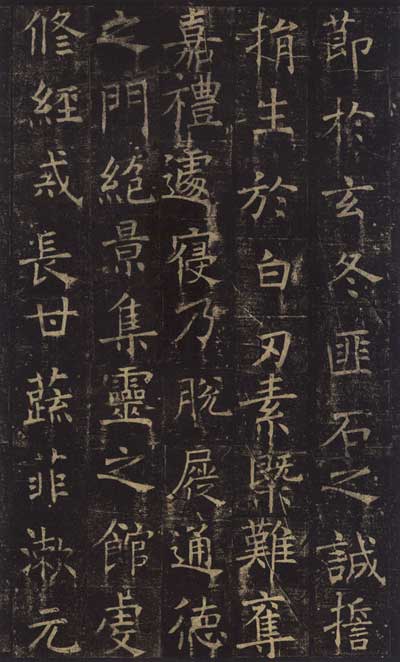
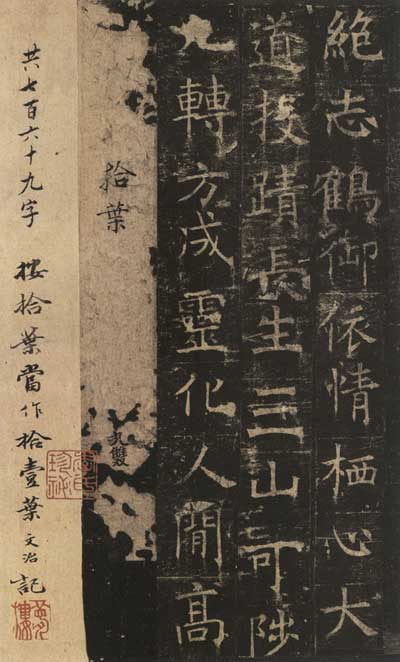
Selected pages from "Master Meng's Monument" by Chu Suiliang
The full name is "The Monument of Master Meng, the Master of the Supreme Virtue of the Capital". An official book inscription from the Tang Dynasty. Chu Suiliang's book was engraved in the twelfth year of Zhenguan (638). There are no surviving tablets. Only the Tang rubbings collected by Li Zonghan of the Qing Dynasty have been handed down. The album has a total of twenty pages, each page has four lines, with nine characters in each line, and there are 769 characters in each line. There are postscripts by Wang Shizhen and Wang Shimao in the Ming Dynasty, and Wang Shu, Wang Wenzhi, Li Zonghan and others in the Qing Dynasty. The calligraphy of this stele is simple, which is different from the clear and flying style of "Yanta Shengdun". The writing style is mostly clerical, which is similar to that of "Yique Buddhist Niche". It is Chu's early work.
Wang Shizhen said: "At the turning point of the waves, there is no trace of regret, which is the treasure in the true ink pool." Wang Shimao's postscript said: "The quality is as Dun Yi, the elegance is like the celestial sphere,... the spirit is bright, and it is eight minutes of ancient meaning.... This is the calligraphy written by Chu Ze." There are Wenming Bookstore and Youzheng Bookstore that photocopied Li Zonghan's version, and Linchuan Li's lithographic version.
Reminder:
Wang Shizhen of the Ming Dynasty: The book written by Chu Gong in the 16th year of Zhenguan is fashionable and deliberately faithful to the original text, while Wei Shen uses the method of dividing official duties, which is the most elegant and full of ancient meaning. There is no trace of regret at the turning point. It is also the most precious treasure in the true ink pool. .
Wang Shizhen of the Ming Dynasty: This "Monument of Master Meng" is a text written by Cen Wen, the minister of Zhongshu, and a book admonishing the official Chu Suiliang. The first seven characters are "Master of the Supreme Virtue of the Capital of the Tang Dynasty", the last thirty-three characters are the year and month, the stele's description is more than a hundred characters, and the poem is twenty-seven characters. It must be that it has been through the ages after being cut and mounted, and the pond has been scattered. Ear. The rubbings engraved in the Tang Dynasty are the most precious in the true ink pool. When Chu was studying the book written in the 16th year of Zhenguan, he still deliberately believed in the original text and made slight reference to the division of official methods, which was the most elegant and ancient meaning. ("Continued Draft of Yanzhou Mountain Man")
Ming Dynasty Mo Shilong: "Master Meng's Monument", Dongpo Appreciation Review said: Chu Henan's book, Qingyuan Xiaosan, has a slight official style, which is exactly what this post is. ("Mo Ting Han Ji")
Li Zonghan of the Qing Dynasty: The beauty is like Yu, the strength is like Europe, and the movement is based on the legacy of division and tribulation. It has been popular for six generations and has been used by more than two kings since ancient times. It is almost a work of great intention in the early years.
Biography of calligrapher:
Chu Suiliang, courtesy name Dengshan, was born in Qiantang, Hangzhou. Tongzhi Sanqi often serves Liangzi. At the end of the Sui Dynasty, he gave up his life for Xue Ju. Ren Gaoping was awarded the title of Kai Cao of the Prince of Qin to join the army. In Zhenguan, he moved to be a living man. He is knowledgeable in literature and history, and works in regular script. Taizong sighed and said: "Yu Shinan died, and there is no one to comment on the book!" Wei Zhengbai saw Suiliang, and the emperor ordered him to serve on the book. Emperor Fang Bo Wang Xi's posthumous post has been widely scrutinized all over the world, but no one can verify its authenticity. There is nothing wrong with what Suiliang wrote. In the fifteenth year, he moved to advise the officials and also knew about daily life.
At that time, many flying pheasants gathered in the palace, and the emperor asked: "What auspiciousness is this?" Suiliang said that Qin Wengong got the female and then the male princes, and Han Guangwu got the male from all over the world. Now the male and female can be seen together to express Mingde. Emperor Yue said: "One cannot stand up without learning. Suiliang's so-called knowledgeable gentleman is a gentleman!" He granted the title of guest to the prince. He joined Huangmen as a minister and participated in the government affairs. The father's death was spared, and he came back to worship Zhongshu Ling.
When the emperor fell ill, he summoned Suiliang and his eldest grandson Wuji and said, "Emperor Wu of the Han Dynasty sent Huo Guang, and Liu Bei entrusted Zhuge Liang. I am entrusting you now. The prince is benevolent and filial, and he has sincerely assisted him." He called the prince and said, "Wuji, Suiliang is here, and Don't worry." Because of his fate, he issued an edict. After Emperor Gaozong ascended the throne, he was granted the title of County Duke of Henan and became the Duke of the County. The incident came out as the assassination history of Tongzhou. At the next year, he was summoned to pay homage to the Minister of Civil Affairs and the third rank of Tongzhongshu, who supervised the compilation of the history of the country and was also a guest of the prince. Go in and pay homage to Shangshu's right servant. Due to the remonstrance, Wu Zhaoyi was established, and when the Wu family was established, he moved to the left to be the governor of Tanzhou in Suiliang. In the second year of Xianqing's reign, he moved to Guizhou. Soon after, he was demoted to Aizhou as the assassin. Suiliang was worried about internal disasters and was afraid that he would not be able to find out the truth after his death, so he confessed to the emperor that the emperor was cowardly and was tied to Empress Wu, who eventually became unconscious. He died at the age of sixty-three. In ancient times, it was said that those who could not be taken away during important festivals were the Duke of Chu.

